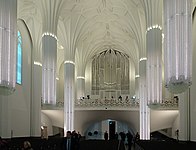
Leipzig is the most populous city in the German state of Saxony. Leipzig's population of 605,407 inhabitants as of 2021 places the city as Germany's eighth most populous, as well as the second most populous city in the area of the former East Germany after (East) Berlin. Together with Halle (Saale), the city forms the polycentric Leipzig-Halle Conurbation. Between the two cities lies Leipzig/Halle Airport.

St John's College is a constituent college of the University of Cambridge founded by the Tudor matriarch Lady Margaret Beaufort. In constitutional terms, the college is a charitable corporation established by a charter dated 9 April 1511. The full, formal name of the college is the College of St John the Evangelist in the University of Cambridge. The aims of the college, as specified by its statutes, are the promotion of education, religion, learning and research. It is one of the larger Oxbridge colleges in terms of student numbers. For 2018, St John's was ranked 9th of 29 colleges in the Tompkins Table with over 30 per cent of its students earning first-class honours.
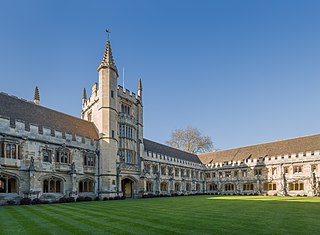
Magdalen College is a constituent college of the University of Oxford. It was founded in 1458 by William of Waynflete. Today, it is the fourth wealthiest college, with a financial endowment of £332.1 million as of 2019 and one of the strongest academically, setting the record for the highest Norrington Score in 2010 and topping the table twice since then. It is home to several of the university's distinguished chairs, including the Agnelli-Serena Professorship, the Sherardian Professorship, and the four Waynflete Professorships.

Brasenose College (BNC) is one of the constituent colleges of the University of Oxford in the United Kingdom. It began as Brasenose Hall in the 13th century, before being founded as a college in 1509. The library and chapel were added in the mid-17th century and the new quadrangle in the late 19th and early 20th centuries.
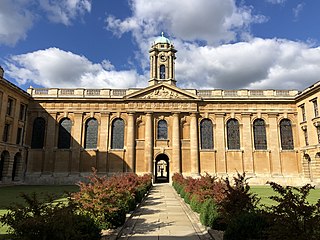
The Queen's College is a constituent college of the University of Oxford, England. The college was founded in 1341 by Robert de Eglesfield in honour of Philippa of Hainault. It is distinguished by its predominantly neoclassical architecture, which includes buildings designed by Sir Christopher Wren and Nicholas Hawksmoor.

King's College in Old Aberdeen, Scotland, the full title of which is The University and King's College of Aberdeen, is a formerly independent university founded in 1495 and now an integral part of the University of Aberdeen. Its historic buildings are the centrepiece of the University of Aberdeen's Old Aberdeen campus, often known as the King's or King's College campus.

The St. Thomas Church is a Lutheran church in Leipzig, Germany. It is associated with several well-known composers such as Richard Wagner and Felix Mendelssohn Bartholdy, and especially Johann Sebastian Bach, who worked here as a Kapellmeister from 1723 until his death in 1750. Today, the church also holds his remains. Martin Luther preached here in 1539.

The Paulinerkirche in the historic city center of Göttingen was completed as a minster in 1304. Today it serves as a convention and exposition centre for the Göttingen State and University Library.

The St. Nikolai-Kirche, is the oldest church in Berlin, the capital of Germany. The church is located in the eastern part of central Berlin, the borough of Mitte. The area around the church, bounded by Spandauer Straße, Rathausstraße, the River Spree and Mühlendamm, is known as the Nikolaiviertel 'Nicholas quarter', and is an area of restored medieval buildings. The church was built between 1220 and 1230, and is thus, along with the Church of Our Lady at Alexanderplatz not far away, the oldest church in Berlin.
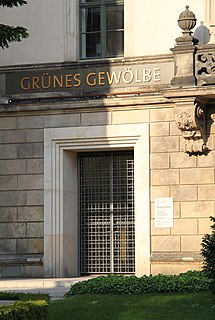
The Green Vault is a museum located in Dresden, Germany, which contains the largest treasure collection in Europe. The museum was founded in 1723 by Augustus the Strong of Poland and Saxony, and it features a variety of exhibits in styles from Baroque to Classicism. The Green Vault is named after the formerly malachite green painted column bases and capitals of the initial rooms. It has some claim to be the oldest museum in the world; it is older than the British Museum, opened in 1759, but the Vatican Museums date their foundation to the public display of the newly excavated Laocoön group in 1506.
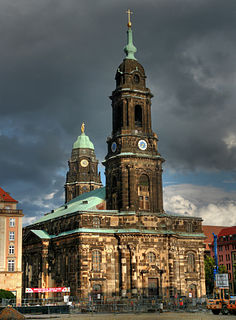
The Dresden Kreuzkirche is a Lutheran church in Dresden, Germany. It is the main church and seat of the Landesbischof of the Evangelical-Lutheran Church of Saxony, and the largest church building in the Free State of Saxony. It also is home of the Dresdner Kreuzchor boys' choir.

The Augusteum was a building on the Augustusplatz in Leipzig, Germany, to the left of the Paulinerkirche. It was built on the original site of the University of Leipzig and served as its main building.

The Paulinerkirche was a church on the Augustusplatz in Leipzig. It was built in 1231 as the Klosterkirche St. Pauli for the Dominican monastery in Leipzig. From the foundation of the University of Leipzig in 1409, it served as the university church. After the Protestant Reformation it was donated to the university and was inaugurated in 1545 by Martin Luther as the Universitätskirche St. Pauli, later also called Unikirche. Johann Sebastian Bach was director of music for "festal" (holiday) services in 1723−25.

The Augustusplatz is a square located at the east end of the city centre of Leipzig. It is the city's largest square and one of the largest squares in Europe. It is also part of the city's inner-city ring-road and a central hub for its tram network.

Buch Abbey, in German Kloster Buch, is a former Cistercian monastery near Leisnig in Saxony.

Stovner Church is a church center in Oslo, Norway.

The Kulturpalast Dresden is a modernist building built by Wolfgang Hänsch during the era of the German Democratic Republic. It was the largest multi-purpose hall in Dresden when it opened in 1969, and was used for concerts, dances, conferences and other events. The building underwent several years of reconstruction beginning in 2012 and opened with a new concert hall in April 2017.

The Dreikönigskirche is a Lutheran church located in the Innere Neustadt of Dresden, Germany. It is the centre of a parish, and a community venue called Haus der Kirche. The church is a listed cultural monument of Dresden.

The Kongreßhalle Leipzig is an event building with several halls on Pfaffendorfer Straße in Leipzig directly next to the entrance to the Leipzig Zoo. Inaugurated in 1900 as the zoo's social hall, the building served as one of Leipzig's most important event venues for more than eight decades. After a long period of vacancy, it was extensively renovated and converted between 2001 and 2015.

The Monastery of Carmelitas Descalzas de San José y Santa Teresa, better known as the Monastery of Santa Teresa in Arequipa, is a religious complex that houses a community of cloistered Discalced Carmelites nuns and the Virceroyalty Art Museum of Santa Teresa. It was founded in 1700 and is a sample of Andean Baroque architecture. It is located in the historic center of Arequipa (Peru), so it is part of the UNESCO World Heritage Site.


